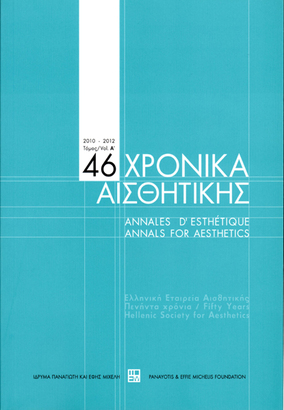Αισθητικές θεωρίες και ορισμοί της τέχνης
Part of : Χρονικά αισθητικής : ετήσιον δελτίον της Ελληνικής Εταιρείας Αισθητικής ; Vol.45, 2009, pages 63-96
Issue:
Pages:
63-96
Parallel Title:
Aesthetic theories and the problem of definition art
Author:
Abstract:
In this paper I shall deal with modern art theories that attempt to reveal the “nature”, “necessary and sufficient conditions”, and/or “definitions” of art. I shall also examine the anti-essentialism in 20th century analytic aesthetics by sampling a wide spectrum of views on art and works of art. I shall focus on the principal question “What is art?”. This has traditionally been interpreted as a question regarding the essential property of art or the essential properties of works of art, and it is connected with traditional art theories that characteristically concentrate on a single concept or principle, which allegedly sums up arts’ essence. I shall deal with the attempts of traditional aesthetic theories to explain art by assuming it has some sort of essence or single manifest property, whether intrinsic or contextual, common to each individual work. Traditional theories of art focus on the nature of art and on a single concept such as mimesis, representation, form, expression or communication of feeling, assuming that works of art are distinguished by something intrinsic to them or by a common quality or essence present in all arts. Essentialism, the search for a common quality or essence of art and the role of theorizing have become a controversial topic in contemporary aesthetics. Aesthetic theorizing, although valuable since - being actually art criticism in disguise - it directs attention to significant facets of artworks, has been critically examined and discussed in the realm of Anglo-American aesthetics during the last fifty years; philosophers belonging to this tradition inspired by Wittgenstein’s Philosophical Investigations - where he objected to the assumption that there is an essence that corresponds to every abstract term or concept, and suggested that for some concepts, e.g. game, there are no necessary and sufficient conditions - opened the discussion on anti-essentialism. They purported to show that traditional aesthetics rest on a mistake, and pointed out the failure of traditional definitions of art to provide true universal generalizations on the arts, as well as their inability to seriously handle the complications introduced by some objects that, though they may be considered art either they are not artifacts - e.g. a piece of driftwood discovered on a beach, which an artist exhibits as art - or they were not originally created as “art”. The latter includes prehistoric cave-painting, religious icons, or medieval sculpture and architecture. Morris Weitz criticized traditional aesthetics in his paper The Role of Theory in Aesthetics’, claiming that “the problem of the nature of art is like that of the nature of games, at least in these respects: If we actually look and see what it is that we call ‘art’, we will also find no common properties - only strands of similarities”; William Kennick’s relevant paper ‘Does Traditional Aesthetics Rest on a Mistake? followed the same line of criticism, assuring us that works of art share only ‘family resemblances’; they both assert the openness of the concept of art and traditional aesthetics’ failure to provide true universal generalizations concerning the arts. In this article I shall review, therefore, the traditional defin itions, highlighting their inability to define art in terms of something intrinsic to each artwork, rather than simply in the light of its historical and social context, i.e., according to the circumstances in which the object is found. I shall focus on George Dickie’s institutional theory of art, which is mainly concerned with art in the “classificatory” and not the “evaluative” sense, as it states that something is a work of art if and only if someone from the “art world” awards it that status, i.e., only inhabitants ofthat realm, artists, critics, gallery staff and select members of the general public, are authorised to adjudicate. According to the institutional theory, in order to recognize art, observers must know where an object fits within a cultural network. This paper also refers to other definitions of art, which include the functional, procedural and historical definitions, which Stephen Davies (1991) presents and explores. Especially it refers to arts’ historical definition, endorsed by Jerrold Levinson, that connects artworks to the history of art. I shall conclude by noticing that contemporary aestheticians appear to be more concerned with identifying individual works of art rather than with defining art, with classifying rather than evaluating works of art and artifacts; I shall also submit that references to both traditional and contemporary art forms, including the avant-garde, enrich our understanding of art theory and artists’ intentions as well as our appreciation of art.
Subject:
Notes:
Η διάλεξη πραγματοποιήθηκε στις 26 Φεβρουάριου 2008




